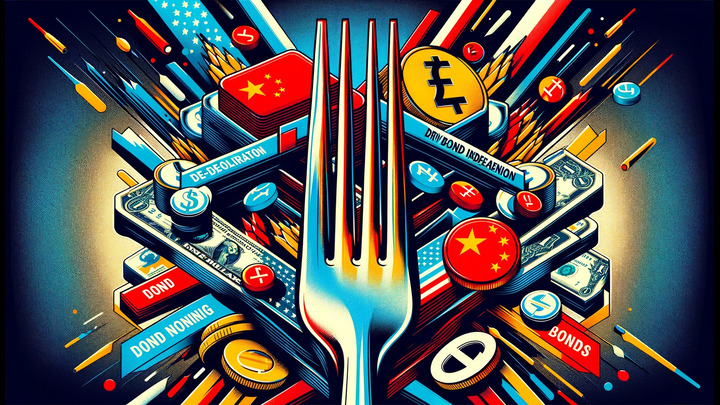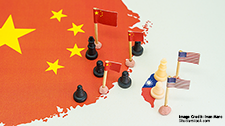Two Tines, One Fork: China’s De-dollarisation and Bond Issuance Drive Economic Independence

Brian Iselin
I wrote earlier this week about China’s announcement of a huge sale of ultralong bonds (Iselin, 2024), and the implications of that sale in geostrategic terms. And already we have a new layer to this discussion.
But we now see also China dumping US bonds; so-called “de-dollarising”. (De Mott, 2024). But what does that mean, alone and in concert with the ultralong bonds issue? Are the solitary measures just coinciding? Or are they tines on a larger geostrategic fork?
My 20c worth is that Zhongnanhai’s move towards de-dollarisation and its current sale of $140 billion in ultralong bonds are interconnected strategies aimed at bolstering its economic resilience and reducing dependency on and vulnerability to the U.S. dollar.
De-dollarisation Strategy
China’s de-dollarisation strategy involves increasing its gold reserves and reducing its holdings of U.S. Treasury securities. This move is designed to insulate the Chinese economy from potential U.S. financial sanctions and to promote the Renminbi as an international currency. By holding more gold and fewer dollars, China clearly seeks to diversify its financial assets and reduce its vulnerability to U.S. economic policies.
$140 Billion Ultralong Bond Sale
The sale of $140 billion in ultralong bonds, with maturities ranging from 30 to 50 years, is part of China’s efforts to stabilise its economy amid rising debt pressures, particularly among local governments. These bonds are intended to raise funds for critical areas such as technological innovation, urban-rural integration, and regional development. The issuance of these bonds reflects China’s need for sustained fiscal support to drive long-term economic growth and stability. The bond sale is strongly about trying to assure potential investors that they should. And reviving a Chinese economy ailing, although not yet on life support.
Commonalities and Strategic Implications
Both de-dollarisation and the bond sale are components of China’s broader economic strategy to achieve greater financial independence and economic stability. Two tines of the one fork. By reducing reliance on the U.S. dollar and securing long-term funding, China aims to enhance its economic sovereignty and resilience against external shocks.
Geopolitical Impact:
- Impact Separately: De-dollarisation reduces China’s exposure to U.S. financial leverage, potentially diminishing the effectiveness of U.S. sanctions. The bond sale provides immediate fiscal support to stabilise local economies and fund strategic initiatives, which could improve domestic economic stability.
- Combined Impact: When combined, these strategies reinforce each other, allowing China to strengthen its economic foundations while simultaneously reducing dependency on the U.S. financial system. This dual approach enhances China’s ability to pursue its geopolitical interests with greater confidence and less vulnerability to external economic pressures. Importantly, this reduced vulnerability to actions within the US financial system leaves China more free to flex its hegemonic biceps without its economy being crippled in reply.
Implications for EU-China Trade
The combined strategy of issuing ultralong bonds and dumping US Treasury bonds carries profound implications for EU-China trade relations, presenting both opportunities and challenges:
- Strengthened Chinese Economy:
- Currency Volatility:
- Geopolitical and Economic Realignments:
- Regulatory and Policy Adjustments:
- Supply Chain Dynamics:
Strengthened Chinese Economy: Stable Trade Partner: The funds raised from ultralong bond sales are earmarked for critical investments in infrastructure, technology, and urban-rural integration. These investments are likely to enhance China’s economic stability and growth, making China a more reliable and robust trade partner for the EU. I believe there is little doubt the new financial position for China would increase the muscularity of its responses to attempts to levy anti-subsidy tariffs, and might even mean more subsidies to undercut foreign competitors. Increased Market Opportunities: With a more stable economy, and more money in the hands of the middle class, Chinese demand for high-quality European goods and services could rise, providing new market opportunities for EU exporters, particularly in sectors like luxury goods, automotive, and high-tech machinery.
Currency Volatility: Impact on Trade Costs: The move away from the US dollar towards greater use of the Yuan could introduce currency volatility. European businesses engaged in trade with China might face increased exchange rate risks, impacting pricing strategies, profit margins, and overall trade costs. Currency Diversification: EU companies may need to diversify their currency holdings and engage in more sophisticated currency hedging practices to mitigate these risks. This could also prompt the EU to consider deeper financial integration with China, possibly increasing the use of the Euro in bilateral trade. This is, of course, bad for those (like me) who argue trade dependence on China is a bigger future strategic risk to the EU than it is a boon.
Geopolitical and Economic Realignments: Strategic Partnerships: As China distances itself from the US financial system, it may seek to strengthen economic ties with the EU as part of its de-dollarisation strategy. This realignment could lead to enhanced cooperation in areas such as digital economy, green technology, and infrastructure development under initiatives like the Belt and Road Initiative. Competition and Collaboration: While the EU may benefit from closer economic ties, it also faces the challenge of balancing its strategic interests. Increased Chinese investments in Europe, facilitated by the capital from ultralong bonds, could lead to heightened competition in key industries, for example in green technology and EVs. The EU must navigate these dynamics carefully to safeguard its economic interests and ensure fair competition.
Regulatory and Policy Adjustments: Adapting Trade Policies: The EU may need to adjust its trade policies and regulatory frameworks to address the evolving economic landscape. This could include measures to support European businesses in managing currency risks, enhancing trade facilitation, and ensuring compliance with new financial regulations arising from China’s economic policies. Securing broad support at the EU level for new trade protection measures as a response to China’s trade distorting measures will be that much harder, as well. Joint Initiatives: The EU might also explore joint initiatives with China to foster economic resilience and stability. Collaborations in financial services, such as developing yuan-euro trading platforms, could facilitate smoother trade transactions and reduce reliance on the US dollar. Again, building trade reliance on China at a time when that is security risk, which will force EU policymakers to ask: Does the security risk outweigh the trade-off on trade?
Supply Chain Dynamics: Resilient Supply Chains: The investments from ultralong bonds are likely to bolster China’s domestic capabilities, potentially reducing its reliance on foreign inputs. For EU companies, this could mean changes in supply chain dynamics, making the current trend towards de-risking supply chains that much harder, necessitating adjustments in sourcing strategies and logistics planning. Technological Partnerships: Enhanced Chinese investment in technology could open new avenues for EU-China technological partnerships. European companies could benefit from access to Chinese advancements in sectors like AI, green energy, and 5G, fostering innovation and growth.
These moves are not without harm, although not without also presenting some opportunities. China’s strategy of de-dollarisation combined with the issuance of ultralong bonds will have numerous implications for EU-China trade. While presenting new opportunities for economic cooperation and market expansion, it also requires the EU to adapt to potential challenges related to currency volatility, competitive pressures, and geopolitical realignments. This strategy also demands an immediate re-think of EU responses to China’s trade distorting measures.
De-dollarisation and the ultralong bond sale are two tines of the same fork aimed at fortifying China’s economic position and reducing its reliance on the U.S. dollar, thereby supporting its broader geopolitical ambitions in East Asia and beyond (Lee, 2024; Liu, 2024). These are not benign moves. Far from it, they lay a foundation for more adventurous, dare I say dictatorial, foreign policy and a stronger position for weaponising trade.
References:
De Mott, F. (2024). China ramps up de-dollarization efforts by dumping a record amount of US bonds. Business Insider. Retrieved from https://markets.businessinsider.com/news/bonds/china-dollar-dominance-dollarization-treasury-bond-yields-gold-buying-spree-2024-5
Iselin, B. (2024), Beyond Debt: How China’s Ultralong Bonds Could Reshape Global Geopolitics. Institute for Security and Development Policy. Retrieved from: https://www.isdp.eu/publication/beyond-debt-how-chinas-ultralong-bonds-could-reshape-global-geopolitics/
Lee, A (2024). What makes China’s ‘ultra-long’ bonds special? Here’s what we know about Beijing’s trillion-yuan offering to stabilise economy. South China Morning Post. Retrieved from https://www.scmp.com/economy/china-economy/article/3256248/what-makes-chinas-ultra-long-bonds-special-heres-what-we-know-about-beijings-trillion-yuan-offering
Liu, Z. (2024). Treasury bonds aim to spur investment, consumption. China Daily. https://www.chinadaily.com.cn/a/202403/06/WS65e82ccfa31082fc043bb031.html
Related Publications
-
The Economic Leash: China’s Financial Tethers and Global Power Plays
China’s emphasis on Gross Domestic Product (GDP) growth and its integration into global markets have allowed it to wield significant influence internationally. Nonetheless, this focus on rapid expansion has created […]
-
The US and EU, and the Emerging Supply Chain Network: Politics, Prospects, and Allies
The Global Supply Chains have evolved from simply logistical achievements to being the bedrock of the global economy. Driven by technological advances and geopolitical shifts, this transformation underscores the critical […]
-
Taiwan-PRC Crisis: What Cross-Strait Conflict Could Cost Europe
The escalating tensions between Taiwan and China pose significant economic and strategic challenges to the European Union, such as the inaccessibility of Taiwanese inputs, market, and capital. This issue brief […]
-
Hegemony at a Crossroads: The Inverse Dynamics of China’s Global Strategy
Here is my bold statement. Hard power projection decimates soft power but only for authoritarian states. In the early 21st century, I was living in Beijing and at that time […]
-
Beyond Debt: How China’s Ultralong Bonds Could Reshape Global Geopolitics
In a bid to revitalize its sluggish economy, China has announced the sale of $140 billion in ultralong bonds. This financial manoeuvre is set in a context marked by declining […]




